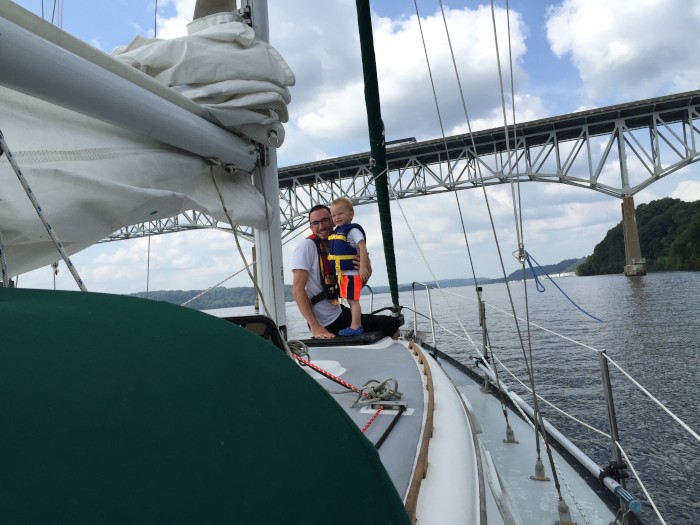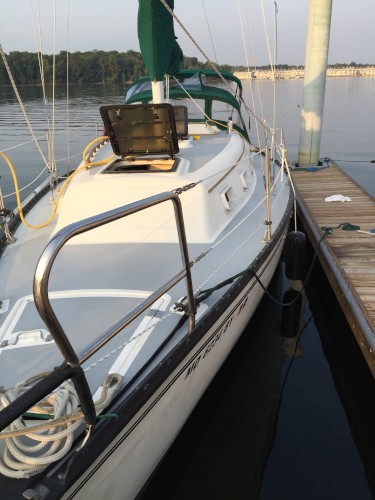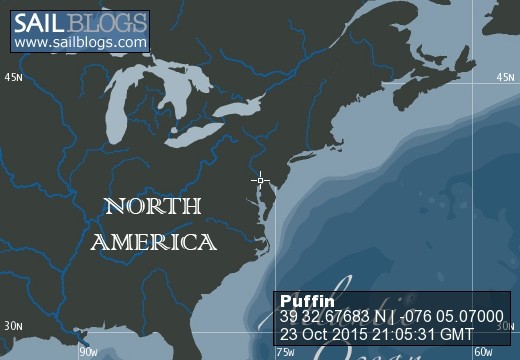
Adventures of the Sailing Vessel Puffin
23 October 2015
23 October 2015 | Susquahana River
Some Rules & Stuff for Sailing Vessel Puffin
23 October 2015
Captain Ed wants everyone who comes aboard Puffin to have an enjoyable and safe experience. Studying some basic yachting rules and terms will enhance that enjoyment and make everyone more comfortable aboard.
No sailboat experience is required and you are not expected to assist in crewing. If, however, you feel confident being sitting in the cockpit and wish to assist then your help will be greatly appreciated. Everyone will have an opportunity to take the helm and be the captain.
Puffin is a 1980 Hunter, 30 feet in length, made mostly of fiberglass and wood. Having two sails and a single mast make it a sloop. It displaces close to 10,000 lbs. and will NOT tip over! It can sleep five or six very friendly people.
First time expectations may need to be adjusted depending upon weather changes and prior experience or lack thereof. We never set sail if the weather conditions are unfavorable or likely to be. We are in constant contact via radio with the NOAA Weather Service. But changes occur, especially on overnights. The boat is comfortable but not large. It is also safe and fun.
A.) Safety First:
1. Wear comfortable clothing and remember it is cooler on the water.
2. Wear shoes/sandals with a "deck" tread, usually rubber with squeegee soles, some dark-colored soles leave marks on the white fiberglass.
3. Bare feet only when sitting down!! All decks are slippery.
4. Good UV-rated sunglasses protect the eyes, maybe with a strap.
5. A good sunscreen is also recommended.
6. Gore-Tex is good for early and late season with rain and cold spray.
7. Some sailors like gloves for handling wet lines (ropes).
B.) When to wear Lifejackets (Personal Flotation Devices (PFD)):
1. All of age ten or under when on marina docks.
2. All of age ten or under while underway (except in the cabin).
3. Always when the captain asks (or puts his/her own PFD on).
4. Always when entering a dinghy to go ashore or returning.
C) When to wear a harness with tether.
a) Outside the cockpit anytime the seas are rough and/or the winds are unsteady.
b) Whenever the captain requests it.
D.) "Person overboard":
a) In this unlikely event yell "man overboard" and DO NOT lose visual contact.
b) NEVER leap to the person's (incl. child's) rescue.
c) Immediately throw any reachable flotation device including cockpit cushions.
d) Hold your hand pointing to the person so that the captain can concentrate on turning the boat and returning.
e) A third person, if available, can locate an available line (rope) and/or boat hook.
5) Emergency Radio:
a) At least two of the crew should know how to place an emergency call on the radio.
b) Be sure to ask the captain how to use the VHF radio to place a call for help.
6) Assisting:
a) Use caution. Never place body parts between the dock or other objects and an 8-ton boat.
b) Use caution. Stay clear of lines and winches; do not wrap lines around your hands.
Conservation:
1) Two resources are in short supply when away from the dock, electricity and water.
2) We have DC power only while sailing, limited to three large car like batteries. These can be recharged by running the diesel, but very slowly. Please conserve by turning off lights not in use and limiting the use of power ports, chargers, fans, and fresh water.
3) Fresh water for washing and showering is limited to what is in the 33 gallon tank (if we remember to fill it). Navy showers are a must: get wet fast and turn off, suds up, rinse fast. And the water might be VERY HOT if the engine has been running.
Seasickness:
1) If susceptible then take medication (oral or patch) before cruising.
2) Or ask the Captain for a wristband (or a Green Apple or a Ginger Snap).
3) Stay busy and warm in fresh air. Avoid greasy and acidic foods.
4) Ask for medication from the First Aid kit.
Use of Head (Toilet):
1) Never be afraid to ask if uncertain about the proper use of anything on the boat.
2) Toilet: directions are on plate behind the toilet.
3) Toilet: only something you already ate or drank and "approved" toilet paper can be placed in toilet.
4) Priming: pump a small amount of water into bowl before use.
5) Flushing: pump three or four times to rinse the bowl into the holding tank.
6) Washing: faucets in the head and kitchen work like normal faucets.
Food and Drink:
1) There is one ice box aboard, and one small A/C powered refrigerator.
2) Alcoholic beverages only when remaining at dock or at anchor.
3) Bring food and drink aboard in plastic or Styrofoam, never paper bags or cardboard boxes.
4) There is presently an alcohol stove in the galley, an A/C powered microwave, and a small propane grill for cooking outside the cabin.
Overnights:
1) Bring clothing and personal affects in soft stuff bags. These store easier.
2) There is limited hanger space but lots of nooks and crannies.
3) Travel light. All party's, on board and ashore, are casual dress.
No sailboat experience is required and you are not expected to assist in crewing. If, however, you feel confident being sitting in the cockpit and wish to assist then your help will be greatly appreciated. Everyone will have an opportunity to take the helm and be the captain.
Puffin is a 1980 Hunter, 30 feet in length, made mostly of fiberglass and wood. Having two sails and a single mast make it a sloop. It displaces close to 10,000 lbs. and will NOT tip over! It can sleep five or six very friendly people.
First time expectations may need to be adjusted depending upon weather changes and prior experience or lack thereof. We never set sail if the weather conditions are unfavorable or likely to be. We are in constant contact via radio with the NOAA Weather Service. But changes occur, especially on overnights. The boat is comfortable but not large. It is also safe and fun.
A.) Safety First:
1. Wear comfortable clothing and remember it is cooler on the water.
2. Wear shoes/sandals with a "deck" tread, usually rubber with squeegee soles, some dark-colored soles leave marks on the white fiberglass.
3. Bare feet only when sitting down!! All decks are slippery.
4. Good UV-rated sunglasses protect the eyes, maybe with a strap.
5. A good sunscreen is also recommended.
6. Gore-Tex is good for early and late season with rain and cold spray.
7. Some sailors like gloves for handling wet lines (ropes).
B.) When to wear Lifejackets (Personal Flotation Devices (PFD)):
1. All of age ten or under when on marina docks.
2. All of age ten or under while underway (except in the cabin).
3. Always when the captain asks (or puts his/her own PFD on).
4. Always when entering a dinghy to go ashore or returning.
C) When to wear a harness with tether.
a) Outside the cockpit anytime the seas are rough and/or the winds are unsteady.
b) Whenever the captain requests it.
D.) "Person overboard":
a) In this unlikely event yell "man overboard" and DO NOT lose visual contact.
b) NEVER leap to the person's (incl. child's) rescue.
c) Immediately throw any reachable flotation device including cockpit cushions.
d) Hold your hand pointing to the person so that the captain can concentrate on turning the boat and returning.
e) A third person, if available, can locate an available line (rope) and/or boat hook.
5) Emergency Radio:
a) At least two of the crew should know how to place an emergency call on the radio.
b) Be sure to ask the captain how to use the VHF radio to place a call for help.
6) Assisting:
a) Use caution. Never place body parts between the dock or other objects and an 8-ton boat.
b) Use caution. Stay clear of lines and winches; do not wrap lines around your hands.
Conservation:
1) Two resources are in short supply when away from the dock, electricity and water.
2) We have DC power only while sailing, limited to three large car like batteries. These can be recharged by running the diesel, but very slowly. Please conserve by turning off lights not in use and limiting the use of power ports, chargers, fans, and fresh water.
3) Fresh water for washing and showering is limited to what is in the 33 gallon tank (if we remember to fill it). Navy showers are a must: get wet fast and turn off, suds up, rinse fast. And the water might be VERY HOT if the engine has been running.
Seasickness:
1) If susceptible then take medication (oral or patch) before cruising.
2) Or ask the Captain for a wristband (or a Green Apple or a Ginger Snap).
3) Stay busy and warm in fresh air. Avoid greasy and acidic foods.
4) Ask for medication from the First Aid kit.
Use of Head (Toilet):
1) Never be afraid to ask if uncertain about the proper use of anything on the boat.
2) Toilet: directions are on plate behind the toilet.
3) Toilet: only something you already ate or drank and "approved" toilet paper can be placed in toilet.
4) Priming: pump a small amount of water into bowl before use.
5) Flushing: pump three or four times to rinse the bowl into the holding tank.
6) Washing: faucets in the head and kitchen work like normal faucets.
Food and Drink:
1) There is one ice box aboard, and one small A/C powered refrigerator.
2) Alcoholic beverages only when remaining at dock or at anchor.
3) Bring food and drink aboard in plastic or Styrofoam, never paper bags or cardboard boxes.
4) There is presently an alcohol stove in the galley, an A/C powered microwave, and a small propane grill for cooking outside the cabin.
Overnights:
1) Bring clothing and personal affects in soft stuff bags. These store easier.
2) There is limited hanger space but lots of nooks and crannies.
3) Travel light. All party's, on board and ashore, are casual dress.
Prepareing for upcoming voyage to Cape May
23 October 2015 | Susquahana River

Working hard on deck!
| Vessel Name: | Puffin |
| Vessel Make/Model: | 1980 Hunter Cherubini 30 |
| Hailing Port: | Havre de Grace, Maryland |
| Crew: | Ed Ward, Captain Steve Ward, Chief Engineer |
| Home Page: | www.svpuffin.com |
| Social: |

Who: Ed Ward, Captain Steve Ward, Chief Engineer
Port: Havre de Grace, Maryland



